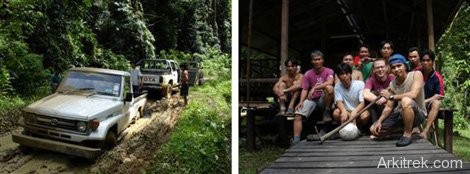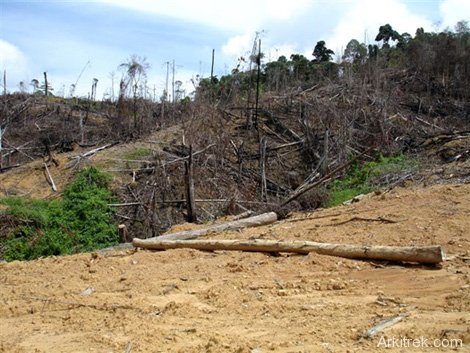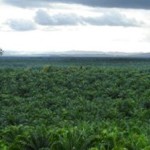Mengaris Tree
I was stripped down to my boxer shorts and with my bare hands was clawing great clods of mud out from under the wheel arch. Occasionally I would take a rest from cleaning and lie down in the shallow water to cool myself off. Even with the help of a second tow truck it had taken us nearly an hour to free an old Landcruiser that had got stuck on the way into Imbak Canyon. All three vehicles were now parked in the middle of the Imbak River to receive a much needed wash.
By way of taking a holiday from Maliau Basin I had decided to pay a visit on my old friends in Imbak Canyon. A lot had changed since I was last there, not least the troublesome new access road extension. At the end of these three kilometres of mud I was pleased to find the rangers happily ensconced in their expansive new basecamp quarters. The shiny tin roofs and plywood floors were a big improvement on the tarpaulin and packed earth that they had put up with for the previous three years. Apart from a few new faces they were much the same if not slightly more mature than I remembered! Maybe this was due to the more homely feel (two of them had even moved in their wives and children), or maybe it was because my visit fell during Ramadan. No doubt after the end of the fasting month they’ll be back on the beer and fags and cheating at cards all night long.
Some readers may question that all this new road and basecamp construction may seem at odds with a pristine virgin rainforest. However think of the infrastructure as a big rubber stamp which says ‘conservation area’. This stamp needs to be as strong as possible because worrying changes are taking place in the world at large.
On this trip I was dismayed to see the encroachment of palm oil plantation right up to the boundary of Imbak. The change had taken place on land which I had had to walk through to reach Imbak on my first visit. On that occasion we had followed an overgrown logging road through mature secondary forest. In order to make way for palm oil any existing vegetation must be clear cut, then burned and finally hillsides are bulldozed into terraces. Trees which I had first known for their protective shade were now charred stumps on naked earth.
With Malaysia’s hardwood exports fast diminishing, palm oil is a viable economic alternative. It will grow almost anywhere and will start to bear fruit three to five years after planting. The market for palm oil is huge, particularly in China where there are a lot of people who like to fry their food. It also sees widespread use in cosmetics and lately in an ironic twist palm oil is being marketed as a bio-fuel that will help reduce our dependency on carbon emitting fossil fuels!
I have spent enough time driving for hours through seemingly endless palm oil plantations to have become almost inured to their presence. Occasionally on the long drive from Lahad Datu to Kalabakan the numbness of the plantations is broken by tall slender mengaris Trees. The Mengaris is an emergent species which means that they rise above the main rainforest canopy, often reaching heights of seventy metres or more. They have broad spreading crowns and smooth silver bark and are said to be the strongest of the rainforest trees. Rangers will happily build their camps under them secure in the knowledge that they are not likely to fall down. Their strength is said to derive from the potent spirits which they harbour. It is out of respect for these spirits that logging contractors will never fell a Mengaris tree. Even once a forest has been logged two or three times and finally clear cut for plantation they will not fell a Mengaris tree. The spirits of a Mengaris tree you see are exceptionally cunning as well as strong; they have ensured that the timber is brittle and of little commercial value and that the high silica content wears a chainsaw blade at a dangerous rate.
Sadly when seen emerging from a canopy of oil palms these magnificent trees are now a symbol of what has been lost. That this is now so close to Imbak gives me fresh cause for concern.
It seems to me that the proliferation of oil palm should be checked immediately. Of course it’s existence is now irreversible but it is not too late to enforce sensible controls on where it is planted and how it is farmed.
Some key concerns that should inform this legislation are; biodiversity conservation, wildlife corridors, riparian reserves, visual amenity (Planner speak for nice views), water catchment protection, soil erosion, siltation and above all protection of remaining primary and secondary forest. There is also a strong economic and agricultural science argument which says that monoculture tends to result in more resilient pests and diseases specific to that crop. In other words, don’t put all your eggs in one basket.
Unfortunately legislation that exists is often not enforced and calls for consumer led regulation, such as to introducing sustainably certified palm oil, are going unhindered.
Of course all of the above concerns are potentially outweighed by the global climate change issue and the question of where are we going to get our energy from? We know that burning fossil fuel produces greenhouse gasses and that this is bad for the climate, but what are the alternatives?
One of them is use biofuel i.e. fuel oil that comes from plants. Burning biofuel still produces carbon dioxide (a greenhouse gas) but the emission of CO2 is exactly equal to the amount of CO2 absorbed by the plant as it grew. This is called carbon neutral i.e. there is no net increase or decrease in carbon emissions.
This would be great if all biofuel crops were grown on existing agricultural land. Unfortunately they are not. In Sabah most biofuel (in this case Palm Oil) is grown on land that was formerly rainforest. The subsequent re-absorption of CO2 by oil palms will not equal the amount that was released by chopping down the rainforest in the first place. In this case the biofuel is neither carbon neutral nor environmentally friendly.
To exacerbate matters, much of the lowland rainforest grows on thick peat swamp. By planting oil palm here you also loose the peat due to fires and erosion. Peat is effectively young coal and destroying it releases an enormous quantity of additional CO2. In this case the net emissions of CO2 by the biofuel may actually be greater than that of coal or petroleum!
The alarming twist is that the European Commission is advocating a switch to biofuel as a means to meet our obligations to cut carbon emissions. Actually this may cut emissions from Europe but unless the biofuel can be certified carbon neutral, there may be a net increase in carbon emissions elsewhere.
Unfortunately this point seems to have been missed by a large number of people, even some of those very clever bureaucrats, politicians and climate change scientists who dreamed up the Kyoto Protocol and Mechanisms such as Carbon Trading.
If you’re interested to read more there is a very good online resource at http://www.biofuelwatch.org.uk/ which also includes stuff you can do to help if you’re so inclined.
Related Posts











Can we see a close-up of you stripped down to your boxer shorts?
I might be in this photo somewhere if you look closely!
Do the 300,000 hectares of Imbak Canyon still remain pristine and unlogged at the moment?
I mean 30,000 hectares 🙂
Hi, Jan. Yes the 30,000ha Imbak Canyon Conservation Area remains intact although it still awaits formal gazettement as a conservation area by the Sabah State Government.
Also, since this post was first published the biofuel controversy has now been picked up by NGO’s and European media. Due to industry lobbying this is yet to be translated into meaningful legislation.
Similarly a certification scheme for oil palm is now available (Round Table for Sustainable Palm Oil) although the initial certificates are criticised by NGO’s as being at best weak and at worst false and misleading.
Subscribe to Biofuelwatch for regular updates
Thank you for the info!